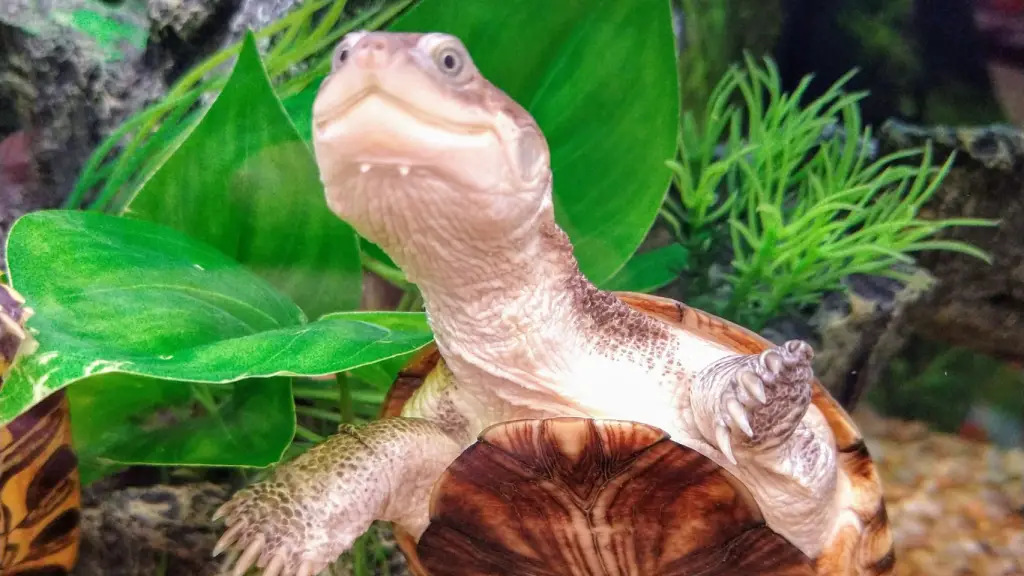African Sideneck Turtles, primarily hailing from the freshwater habitats of Sub-Saharan Africa, are uniquely characterized by their inability to fully retract their heads into their shells, instead tucking them in sideways.
These turtles, belonging to the family Pelomedusidae, are recognized for their distinctive long necks and prominent nostrils, often leading them to be endearingly referred to as ‘mud turtles.’
In captivity, their expected lifespan extends up to 25 years or more with proper care, thriving best in environments that mimic their natural habitat with a balanced combination of land and water areas. These omnivorous reptiles have a varied diet ranging from insects and fish to vegetables and specialized turtle feed.
As captivating as they are to observe, African Sideneck Turtles require attentive care, making it crucial for prospective owners to understand their specific needs in terms of diet, habitat, and health management.
| Topic | Information |
|---|---|
| Species Origin | Native to the freshwater waters of Western and Central Africa, found in rivers, lakes, and swamps |
| Physical Characteristics | Medium-sized turtles up to 12 inches in length, long necks, barbels, sharp claws, oval-shaped dark brown shells, and olive/brown skin |
| Behavior and Temperament | Active during the day, comfortable in both water and land, generally docile and friendly, enjoy the company of other turtles |
| Habitat Requirements | In the wild: Swamps, ponds, and lakes in Madagascar and Seychelles. In captivity: Aquarium or enclosure at least 40 gallons with both a water and a basking area, consistent temperature of 75-80°F (water), 90-95°F (basking), humidity 60-70% |
| Feeding and Diet | Omnivores, in captivity they need a balanced diet of 50% animal protein and 50% vegetation |
| Health and Care | Common issues: Respiratory infections, Vitamin A deficiency. Preventive care: Regular cleaning of the tank, maintaining temperature and humidity, gentle handling, regular water changes |
| Breeding and Reproduction | Lay eggs twice a year; male matures at 3-5 years, female at 5-7 years. Hatchlings require separate enclosures with appropriate temperature and humidity |
| Choosing Your African Sideneck Turtle | Recommend getting from a reputable breeder over the wild due to environmental and health concerns |
| Species Variations | African Helmeted Turtle, Crocodile Turtle, African Side-Necked Turtle |
African Sideneck Turtle Origin

The African sideneck turtle, also known as the African side-necked turtle, is a semi-aquatic species that are native to the freshwater waters of Western and Central Africa. Specifically, these turtles are found in the rivers, lakes, and swamps of Angola, Senegal, Liberia, Guinea, and the Congo.
In the wild, African sideneck turtles inhabit various aquatic environments, from permanent lakes and rivers to temporary pools that may contain water only for a few weeks at a time. They are well adapted to their natural habitat and can often be found basking on logs or rocks in the sun or hiding in the water to avoid predators.
As a freshwater species, the African sideneck turtle is highly dependent on the quality of its aquatic environment. They require clean, well-oxygenated water to thrive, and pollution and habitat destruction often threaten their natural habitat.
It is essential to provide African sideneck turtles with a suitable aquatic environment in captivity, including a large, clean tank with plenty of swimming space and a basking area. By recreating the natural environment of these turtles, you can help ensure their health and well-being- in captivity.
Physical Characteristics
Size and Appearance
African Sideneck Turtles are medium-sized turtles that can grow up to 12 inches long. They have long necks with barbels and sharp claws. The turtle has black markings on its head, big round eyes, and an upturned mouth. The shell of the African Sideneck Turtle is dark brown and oval-shaped. The turtle’s skin is olive/brown.
Shell and Skin
The shell of the African Sideneck Turtle is rugged and durable. It is dark brown and is oval-shaped. The turtle’s skin is olive/brown and has a scaly texture. The skin is also covered in tiny bumps that help the turtle grip onto surfaces while swimming.
Unique Features
The African Sideneck Turtle has a few unique features that distinguish it from other turtles. The turtle has a long neck that can bend sideways, hence its name. It also has barbels on its chin to sense its surroundings. The turtle’s sharp claws are used for digging and climbing.
Behavior and Temperament
African Sideneck Turtles are known for their unique behavior and temperament. They have longer necks than most other turtles species, giving them a distinct advantage over their fellow turtles. If they turn upside-down, these turtles can right themselves using their neck muscles.
These turtles are active during the day and love to dig. They are comfortable in both water and land environments, so it’s essential to provide them with a spacious enclosure that includes both swimming and dry areas. African Sideneck Turtles are also known to be exceptionally social and enjoy the company of other turtles. However, it’s important to note that they can become aggressive toward each other if they feel threatened or if there isn’t enough space in their enclosure.
In terms of temperament, African Sideneck Turtles are generally docile and friendly. They can become quite curious and playful once settled into their new home. However, giving them time to adjust to their new surroundings is essential, and not handle them too much.
Habitat Requirements
In the Wild
African Sideneck Turtles are commonly found in the wild in Madagascar and Seychelles, living in swamps, ponds, and lakes. Their habitat is prone to seasonal flooding, so they need an environment that can withstand occasional flooding.
They prefer shallow water bodies with plenty of vegetation, which provides cover and food. In the wild, they bask on rocks or logs in the sun to regulate their body temperature.
In Captivity
When it comes to keeping African Sideneck Turtles in captivity, it is essential to replicate their natural habitat as closely as possible. Housing them in an aquarium or enclosure of at least 40 gallons is recommended. The enclosure should have both a water and a basking area. The water should be deep enough for the turtle to swim and have a submersible water heater to maintain a consistent temperature of 75-80°F.
The basking area should be dry and have a temperature of around 90-95°F. Use a basking lamp to provide heat and a UVB light to help the turtle metabolize calcium and synthesize vitamin D3. The enclosure should also have a hiding spot, a pile of rocks, or a cave-like structure.
Maintaining the proper humidity level is crucial for the turtle’s health. Use a hygrometer to monitor the humidity level, which should be around 60-70%. The enclosure should be cleaned regularly to prevent bacterial growth and to maintain a healthy environment for the turtle.
Feeding and Diet
In the Wild
African Sideneck Turtles are omnivores, meaning they eat both plants and animals. In the wild, they feed on various food sources, such as fish, insects, worms, and vegetation. They are known to be opportunistic feeders, meaning they will eat whatever is available.
In Captivity
When feeding your African Sideneck Turtle in captivity, it’s essential to provide a balanced diet that meets their nutritional needs. A healthy diet for your turtle should consist of 50% animal protein and 50% vegetation.
You can feed your turtle various foods, including turtle pellets, mealworms, fruits, and vegetables. It’s important to avoid feeding your turtle too much protein, as this can lead to health problems such as shell deformities.
To ensure your turtle is getting enough calcium, add a calcium supplement to their food or provide them with a cuttlebone to gnaw on. Calcium is essential for maintaining healthy bones and shell growth in turtles.
When feeding your turtle, monitoring their intake and adjusting their diet is essential. Overfeeding can lead to obesity and other health problems, so feeding your turtle the appropriate amount of food is essential based on size and activity level.
A healthy diet for your African Sideneck Turtle should include a balanced mix of animal protein and vegetation, with calcium supplements added as needed. Providing your turtle with a nutritious diet can help ensure that they live a long and healthy life.
Health and Care
As a responsible pet owner, it’s essential to prioritize the health and care of your African Sideneck Turtle. This section will cover common health issues and preventive care techniques to ensure your turtle lives long and healthy.
Common Health Issues
One of the most common health issues African Sideneck Turtles face is respiratory infections. Poor water quality, low temperatures, or high humidity can cause this. If you notice your turtle coughing, wheezing, or breathing difficulty, it’s essential to seek veterinary care immediately.
Another health issue to watch out for is Vitamin A deficiency. This can occur if your turtle’s diet is not balanced correctly. Symptoms of Vitamin A deficiency include swollen eyes, nasal discharge, and lack of appetite. To prevent this, ensure your turtle gets a varied diet that includes plenty of leafy greens and other vegetables.
Preventive Care
Preventive care is crucial to the overall health and wellbeing of your African Sideneck Turtle. Here are some tips to keep in mind:
- Clean your turtle’s tank regularly to prevent the buildup of harmful bacteria and parasites.
- Maintaining a consistent temperature and humidity level ensures your turtle’s comfort and health.
- Handle your turtle gently and avoid excessive handling to prevent stress and injury.
- Monitor your turtle’s behavior and appetite to detect potential health issues early on.
- Perform regular water changes to maintain clean and healthy water for your turtle.
African Sideneck Turtles can live up to 50 years or more with proper care and attention. By following these preventive care techniques and promptly addressing any health issues, you can help ensure your turtle lives long and healthy.
Breeding and Reproduction
Breeding African Sideneck Turtles is a fascinating process that requires careful attention to the turtle’s needs. The African sideneck turtles lay eggs twice a year, especially during the dry or harmattan season. However, the laid eggs in the dry season hatch during the wet rainy season. A fertile female sideneck turtle lays 8-16 eggs in a single cycle.
Cool African sideneck turtles to a temperature of 60 degrees Fahrenheit for about eight weeks to initiate the breeding process. The male African sideneck turtle is sexually mature at 3-5 years, while the female African sideneck turtle will breed when she is 5-7 years old.
When breeding African Sideneck Turtles, it’s essential to ensure that the male and female turtles are healthy and well-fed. A well-fed turtle is likelier to breed successfully, and a healthy turtle will produce healthier hatchlings.
After the female African Sideneck Turtle lays her eggs, providing a suitable environment for the hatchlings is important. Hatchlings are delicate and require a lot of care. You should provide a separate enclosure for the hatchlings and ensure appropriate temperature and humidity levels.
Choosing Your African Sideneck Turtle
When choosing your African Sideneck Turtle, there are two main options: getting one from the wild or from a reputable breeder.
From the Wild
While it may be tempting to catch a turtle from the wild, it’s important to note that this can harm the environment and the turtle. Additionally, wild turtles can carry diseases and parasites that can harm both the turtle and other pets in your household. It is recommended to avoid getting a turtle from the wild unless you are an experienced turtle keeper and have the proper permits to do so.
From a Breeder
Getting your African Sideneck Turtle from a reputable breeder is the best option for most people. A good breeder will ensure that the turtle is healthy, free of diseases and parasites, and has been adequately cared for. They will also be able to provide you with information on the turtle’s history and any special care requirements.
When choosing a breeder, it’s essential to do your research. Look for breeders with a good reputation and positive reviews from previous customers. You can also ask for recommendations from other turtle keepers or your local pet store.
It’s important to note that not all breeders are created equal. Avoid purchasing from breeders who do not provide adequate care for their turtles or do not have proper breeding practices. This can lead to health problems for the turtle and potentially other pets in your household.
Species Variations
African Sideneck Turtles belong to the family Pelomedusidae, which encompasses several species. This section will discuss the three most common species variations of African Sideneck Turtles.
African Helmeted Turtle
The African Helmeted Turtle, also known as Pelomedusa Subrufa, is the most common species of African Sideneck Turtle. They are found in freshwater habitats throughout sub-Saharan Africa. These turtles have a brown or olive-colored shell with a distinctive pattern of yellow stripes or spots. They have a lifespan of 25 to 50 years in captivity and can grow up to 12 inches in length.
Crocodile Turtle
The Crocodile Turtle, also known as Mecistops Cataphractus, is a species of African Sideneck Turtle native to Central and West Africa. They are named for their crocodile-like appearance, with a broad, flattened head and a heavily armored shell. These omnivorous turtles are known to eat fish, insects, and vegetation. They can grow up to 18 inches in length and have a lifespan of up to 50 years in captivity.
African Side-Necked Turtle
The African Side-Necked Turtle, also known as Pelusios Castaneus, is a species of African Sideneck Turtle native to East Africa. They are named for their unique ability to tuck their head and neck sideways under their shell for protection.
These turtles have a brown or olive-colored shell with a distinctive pattern of yellow stripes or spots. They are omnivorous and can grow up to 10 inches in length. In captivity, they can live up to 25 years.
Conclusion
African Sideneck Turtles have several species variations, each with unique characteristics and habitats. Whether you are interested in the African Helmeted Turtle, the Crocodile Turtle, or the African Side-Necked Turtle, it is important to research and understand the specific needs of each species before bringing one home as a pet.




Leave a Reply